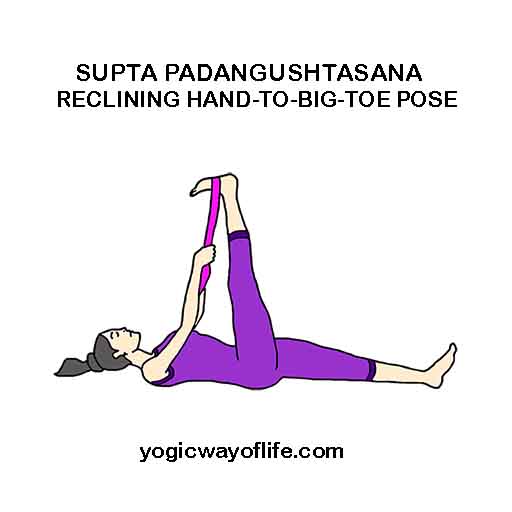Supta Padangushtasana or the reclining Hand to Toe Pose loosens up the hip and hamstring muscles. In Sanskrit, Supta means supine, Pada means leg, Angushta means the toe and Asana means a Pose. Supta Padangushtasana is a yoga Asana in which you touch the big toe of the feet with the hands in the lying down position. For those who find it difficult to reach the toes of the leg with the hands, a strap can also be used.
How to do Supta Padangushtasana (Reclining Hand to Toe Pose)?
- Lie on the floor with the legs stretched and hands relaxed on the sides.
- Bend the right leg at the knee. Bring the knee close to the chest.
- Hold the big toe of the right foot with the fingers. Alternatively, you can also use a strap to hold the right foot together.
- Slowly, straighten the right leg till it is about 60 degrees to the ground. Pull the right leg further up, slowly towards you to make it at 90 degrees to the ground. Meanwhile, keep the left leg straight, resting on the floor. With practice, one can pull the right leg further towards the head, opening up the hamstring muscles fully.
- Breathe normally in this position and hold the big toe with the fingers (or the strap) for as long as you are comfortable.
- To release the position, exhale and bend your right knee. Straighten out the right leg and bring it down to the floor.
- Breathe normally and rest for few seconds and repeat the same process with the left leg.
Benefits of Supta Padangushtasana (Reclining Hand to Toe Pose)
- Supta Padangushtasana loosens up the hip muscles and relieves lower back pain.
- It gives a good stretch to the hamstring muscles and makes the legs flexible.
- It strengthens the knees and the hip joints.
- Supta Padangushtasana helps to relieve sciatic pain.
- It can relieve menstrual pain.
- It is good for those suffering from osteoarthritis of hips and knee joints.
Contraindications for Supta Padangushtasana
Those suffering from asthma, bronchitis, diarrhoea and headaches should avoid this pose.

